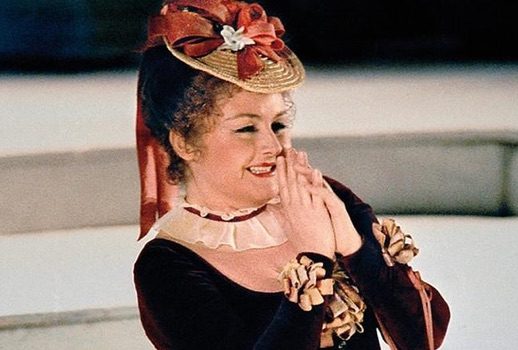

Zerbinetta, opera’s first, unabashedly polyamorous good-time girl, was the role that catapulted Gruberova into international stardom. Though she first essayed it 1973, it was not until the Vienna State Opera’s 1976 production of Ariadne auf Naxos, designed by Filippo Sanjust and conducted by Karl Böhm, that caused her to gain widespread fame.
Fortunately, the opening night was broadcast, and you can hear the excitement of that, as well as the Viennese’s boisterous reception:
Gruberova went on to sing the role over 200 times, recording it commercially twice, and participating in a 1978 Unitel filming of what is basically the Sanjust staging, as well as in two televised productions from Barcelona. In addition, there are dozens of pirated broadcasts, in-house recordings and videos circulating in collections and on YouTube, including her very last one in 2009.
Orfeo Records put out as well two live archival recordings: The premiere of the Vienna State Opera opening night, and the same company’s visit to Washington D.C. in 1979. It would be safe to conjecture that hers is the most-documented Zerbinetta of all time.
I will readily confess that when I first heard the aria, I did not like it. Used to the melodically tuneful, traditionally acrobatic coloratura arias I was weaned on, “Großmächtige Prinzessin!” sounded at first too declamatory, and then the florid passages seemed to me almost dementedly, haphazardly weird, alien as melody went. Crazy intervals, an excess of trills, and it all sounded like positively ugly music.
Then I began to study it. Score, translation, the way the text corresponded with the music. Matching what Zerbinetta was actually communicating in tandem with the crazy coloratura.
It finally began to make sense.
As Barbara Cook in her masterclasses used to say, “What is this song about? It’s about SEX.”
Zerbinetta, after expounding about the male-female dynamic, launches into her sexual escapades: there was Pagliazzo and Mezzetin…then it was Cavicchio, then Burattin, oh, and Pasquariello! And sometimes there were TWO.
She tells of being bereft of speech as each one came like a god, how he kissed her brow and cheek, and her becoming captive and transfigured…and how she surrendered without a word. Zerbinetta is opera’s first lady bountiful of the sheets, a post fin-de-siecle modern woman of the 20th century.
The second half of the piece, particularly the Rondo section, is, basically, a series of sensual figurations of feminine ecstasy, expressive quivers and chuckles of erotic delight; all those copious trills, especially the one attached to the concluding part of the prolonged, climactic high D – are orgasmic in essence.
Hoffmannsthal’s text complements Strauss’s music with brilliant synchronicity, but how often has this element been truly realized by sopranos who’ve essayed the role? How many of them, sounding like over-stretched soubrettes, really conveyed the frankly sexual aspects of the scene’s internal meanings?
To see what I mean, here is a YouTube clip of Gruberova doing the scene in 1982:
https://?t=996
This happens to be my favorite overall document of Gruberova’s classic characterization. It is from the staging of her first great triumph in the Sanjust production. The role has well “settled” into her voice and physical portrayal, so that it has emerged with absolute assurance; and she looks to be having a grand old time of it. The audio captures the most warm quality of tone(which I didn’t feel was the case in her commercial recordings).
Here, too, you will see the superior technique wedded with the text, and that in turn is depicted in her delightful, charming characterization.
Nowhere is there the slightest hint that the music is causing her any strain; the words are integrated into the line no matter how treacherous it gets, the triplets, intervals and trills negotiated with supreme ease of delivery. The breaths are long, and carry the line effortlessly through even the most difficult passages. At 26:17 the high E is done with an astounding messa-di-voce, and it emerges as an expression of ecstasy in the process.
But wait, she’s not done yet.
Could she do a the original, longer version of this aria, with most of it in a higher key?
She’d be delighted to. In October of 1983, Gruberova sang the 1912 version of the aria for a concert, televised live.
This version is even more dementedly difficult than the more commonly sung 1916 revision. It is not as well-constructed either, nor as specific in intent as the later one; it meanders on for an eternity in excessive, almost numbingly endless coloratura fireworks.
None of this causes Gruberova any distress: in fact, this is one of her greatest vocal accomplishments, a testament to the superiority of her technique. She sails through this with jaw-dropping ease; and you probably will never hear a more huge high F# like this one… and with a diminuendo on it, to boot (at 20:35).
https://?t=638

























Comments